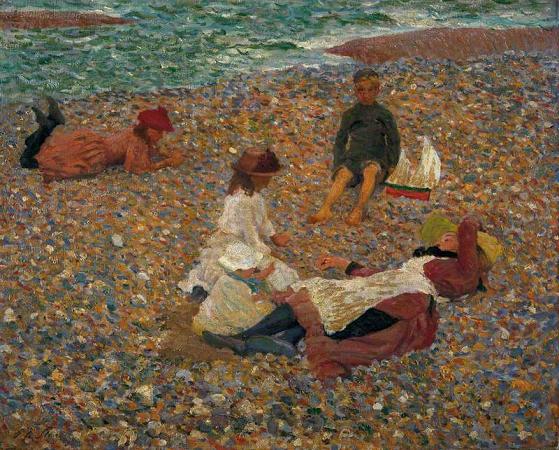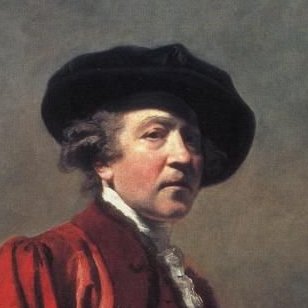Gwen John (1876 - 1939). Gwendolen Mary John was a Welsh artist who worked in France for most of her career. Her paintings, mainly portraits of anonymous female sitters, are rendered in a range of closely related tones. Although she was overshadowed during her lifetime by her brother Augustus John and her lover Auguste Rodin, her reputation has grown steadily since her death. Gwen John was born in Haverfordwest, Wales, the second of four children of Edwin William John and his wife Augusta. Gwen's elder brother was Thornton John; her younger siblings were Augustus and Winifred. Edwin John was a solicitor whose dour temperament cast a chill over his family, and Augusta was often absent from the children owing to ill health, leaving her two sisters, stern Salvationists, to take her place in the household. Augusta was an amateur watercolourist, and both parents encouraged the children's interest in literature and art. Her mother died when Gwen was eight years of age. Regarding her mother's death and the loss of her influence, her brother, Augustus, later wrote: My mother would no doubt have been helpful, but she died when I was a small child, after, I fear, a very tearful existence. Following their mother's premature death in 1884, the family moved to Tenby in Pembrokeshire, Wales, where the early education of Gwen and her sister Winifred was provided by governesses. In addition to her sister, she also had two brothers, Thornton and Augustus. The siblings often went to the coast of Tenby to sketch. John said that she would make rapid drawings of beached gulls, shells and fish on stray pieces of paper, or sometimes in the frontispiece of the book she was reading. Although she painted and drew from an early age, Gwen John's earliest surviving work dates from her nineteenth year. From 1895 to 1898, she studied at the Slade School of Art, where the program was modeled after French atelier methods. It was the only art school in the United Kingdom that allowed female students, although there was generally no mixing of men and women on the grounds, in classes, or in corridors. Like her younger brother, Augustus, who had begun his studies there in 1894, she studied figure drawing under Henry Tonks. During this period, she and Augustus shared living quarters, and further reduced their expenses by subsisting on a diet of nuts and fruit. She developed a close relationship with the woman who would become her brother's wife, Ida Nettleship. At this time, she also had a relationship with another of her brother's friends, Arthur Ambrose McEvoy, which turned out to be an unhappy relationship. Good friends also included Ursula Tyrwhitt and Gwen Salmond. John won the Melvill Nettleship Prize for Figure Composition in her final year at Slade. Slade students were encouraged to copy the works of old masters in London museums. John's early paintings such as Portrait of Mrs. Atkinson, Young Woman with a Violin, and Interior with Figures are intimist works painted in a traditional style characterised by subdued colour and transparent glazes. Even as a student, Augustus's brilliant draughtsmanship and personal glamour made him a celebrity, and stood in contrast to Gwen's quieter gifts and reticent demeanour. Augustus greatly admired his sister's work but believed she neglected her health, and urged her to take a more athletic attitude to life. She refused his advice, and demonstrated throughout her life a marked disregard for her physical well-being. In 1898 she made her first visit to Paris with two friends from the Slade, and while there she studied under James McNeill Whistler at his school, Academie Carmen. She returned to London in 1899, and exhibited her work for the first time in 1900, at the New English Art Club. Her material circumstances were poor, and in 1900-01 she lived as a squatter in a derelict building. In the autumn of 1903, she travelled to France with her friend Dorelia McNeill. Upon landing in Bordeaux, they set off on a walking tour with their art equipment in hand, intending to reach Rome. Sleeping in fields and living on money earned along the way by selling portrait sketches, they made it as far as Toulouse. In 1904 the two went to Paris, where John found work as an artist's model, mostly for women artists. In that same year, she began modelling for the sculptor Auguste Rodin, and became his lover. Her devotion to the much older Rodin, who was the most famous artist of his time, continued unabated for the next ten years, as documented in her thousands of fervent letters to him. John was given to fierce attachments to both men and women that were sometimes disturbing to them, and Rodin, despite his genuine feeling for her, eventually resorted to the use of concierges and secretaries to keep her at a distance.
more...












